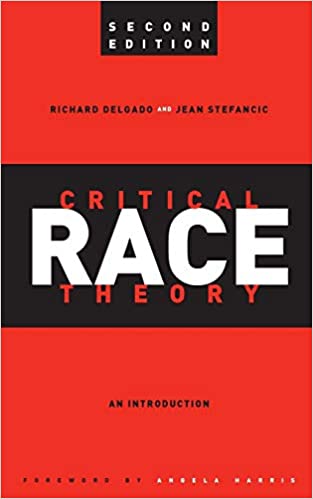There’s been an awful lot of loose talk about “critical race theory” (CRT) and how it is being taught in everywhere from grade school to college. Most of the people who use the term have little idea what CRT actually is – instead it’s used as a catch-all for any kind of talk or lessons about the history of race in the United States that deals with racism and white supremacy.
In part one of this series, we got a brief introduction to what critical theory is. In this second post in a series, we’re going to take a simplified look at how critical theory gets applied to race aka Critical Race Theory (CRT).

Critical Race Theory: An Introduction by Richard Delgado and Jean Stefancic gives a good overall introduction to the topic of critical race theory.
Historian and author Justin Hart wrote an excellent series of tweets a month ago that sum up the rhetoric surrounding CRT in which he points out that CRT “originated in legal scholarship in the early 1980s with scholars such as Derrick Bell, Kimberlé Crenshaw, Patricia Williams and others.”
An article on CRT published by the American Bar Association’s Civil Rights and Social Justice Group by Janel George provides a good introduction. She writes that legal scholar Kimberlé Crenshaw created the term “critical race theory” to describe “a practice of interrogating the role of race and racism in society that emerged in the legal cademy and spread to other firelds of scholarship.” Crenshaw points out that like with so much of critical theory, it is a process rather than a thing – a verb, not a noun. It is a method of study, not a set of answers.
The article lists several key principles of CRT:
- Race is not biologically real but is a “socially constructed and socially significant.” Race is sociology, not biology.
- Racism is a normal part of society and is build into our systems and institutions, including our legal system. It is not he product of “racists” but of how society operates.
- Racism is not the product of a few bad people, of racists; instead it is built into our laws and public policy.
- People’s everyday lives shape their scholarship and the way they see the world around them. It is important to look at how people of color see and experience the world. Their lived experiences matter.
If you go back to the previous post, you can start seeing how this clearly comes out of the history of critical theory. The principles are critical theory and CRT are clearly connected.
Dr. Katheryn Schumaker, a professor at University of Oklahoma, provides a good example of how critical race theory gets applied by academics in her essay published in May in the Washington Post:
“For example, Harvard law professor Derrick Bell took a critical lens to one of the court’s most hallowed decisions: Brown v. Board of Education. Despite the unanimity of the court’s 1954 decision, little actual desegregation took place in the United States until the Supreme Court began enforcing Brown in the late 1960s. In 1976, Bell published a provocative law-review article that argued that the focus on implementing Brown through elaborate desegregation plans came at the cost of the pursuit of meaningful educational equity for Black children. The courts were consumed with the minutiae of busing plans and student assignments. But this focus on busing, Bell argued, failed “to encompass the complexity of achieving equal educational opportunity for children to whom it has so long been denied.” Bell was not just theorizing — he knew school desegregation litigation intimately through his work on hundreds of cases at the NAACP Legal Defense Fund in the 1960s.”
This is, of course, far from a comprehensive look at CRT. If you are interested in diving in a bit deeper into how critical race theory is seen as a realm of academic investigation, I would recommend reading Critical Race Theory: An Introduction by Richard Delgado and Jean Stefancic for a good overall introduction to the topic.
Coming next: How critics portray critical race theory.
